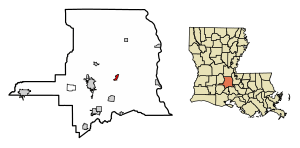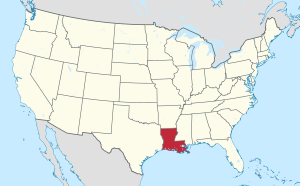Port Barre, Louisiana facts for kids
Quick facts for kids
Port Barre, Louisiana
|
|
|---|---|
|
Town
|
|
| Town of Port Barre | |

Location of Port Barre in St. Landry Parish, Louisiana.
|
|

Location of Louisiana in the United States
|
|
| Country | United States |
| State | Louisiana |
| Parish | St. Landry |
| Area | |
| • Total | 1.12 sq mi (2.89 km2) |
| • Land | 1.08 sq mi (2.79 km2) |
| • Water | 0.04 sq mi (0.10 km2) |
| Elevation | 23 ft (7 m) |
| Population
(2020)
|
|
| • Total | 1,751 |
| • Density | 1,624.30/sq mi (627.35/km2) |
| Time zone | UTC-6 (CST) |
| • Summer (DST) | UTC-5 (CDT) |
| ZIP code |
70577
|
| Area code(s) | 337 |
| FIPS code | 22-61825 |
| Website | https://www.townofportbarre.com |
Port Barre (BAH-ree) is a town in St. Landry Parish, Louisiana, United States. The town began in 1760 as an Indian trading post at the place where Bayou Teche flows out of Bayou Courtableau. The population was 2,055 at the 2010 census, down from 2,287 in 2000. It is part of the Opelousas–Eunice Micropolitan Statistical Area and home to the Port Barre High School Red Devils.
Contents
Geography
Port Barre is located at 30°33′22″N 91°57′30″W / 30.55611°N 91.95833°W (30.556162, -91.958465), approximately 6 miles east of Opelousas, LA, at the confluence of Bayou Courtableau and Bayou Teche.
According to the United States Census Bureau, the town has a total area of 1.1 square miles (2.8 km²), all of it land.
Demographics
| Historical population | |||
|---|---|---|---|
| Census | Pop. | %± | |
| 1920 | 588 | — | |
| 1930 | 674 | 14.6% | |
| 1940 | 850 | 26.1% | |
| 1950 | 1,066 | 25.4% | |
| 1960 | 1,876 | 76.0% | |
| 1970 | 2,133 | 13.7% | |
| 1980 | 2,625 | 23.1% | |
| 1990 | 2,144 | −18.3% | |
| 2000 | 2,287 | 6.7% | |
| 2010 | 2,055 | −10.1% | |
| 2020 | 1,751 | −14.8% | |
| U.S. Decennial Census | |||
2020 census
| Race | Number | Percentage |
|---|---|---|
| White (non-Hispanic) | 1,137 | 64.93% |
| Black or African American (non-Hispanic) | 528 | 30.15% |
| Native American | 1 | 0.06% |
| Asian | 3 | 0.17% |
| Other/Mixed | 56 | 3.2% |
| Hispanic or Latino | 26 | 1.48% |
As of the 2020 United States census, there were 1,751 people, 680 households, and 469 families residing in the town.
2010 census
As of the 2010 United States Census, there were 2,055 people living in the town. The racial makeup of the town was 70.7% White, 25.6% Black, 0.1% Native American, 0.2% Asian and 1.8% from two or more races. 1.6% were Hispanic or Latino of any race.
History
Port Barre takes its name from Alex Charles Barre (born 1746, died 1829).
In 1733, the semi-nomadic Opelousas Indians petitioned the French colonial government to send traders to their district. in 1760, a couple of coureurs des bois who had come to the area in search of trade opportunities set up a trading post where the bayous meet.
In 1765, Jacques Courtableau, a wealthy landowner, gave land grants to 32 Acadian immigrants. That same year, he sold a large parcel of land including the site of the first trading post to Charles Barre. The post later became known as Barre’s Landing, then Port Barre. It thrived as a port town before the days of the railroads.
Alex Charles Barre is one of the descendants of Guillaume Barre, a Frenchman born 1642 in St. Valery, France, who settled about 1665 at Martinique in the French West Indies. There Guillaume Barre met Jean Roy (1625–1707) and Jean Hebert (1624), and the destinies of the three families were bound forever. They left Martinique and settled in Louisiana.
The Barres settled in Pointe Coupee, LA, where they met the Nezat family (Pierre Nezat coming from Santo Domingo (French Saint Domingue, the western part of Hispaniola) and the Provost family (Nicolas Provost coming from Paris via Fort de Chartres, IL). In 1765, Charles Alex Barre bought a large parcel of land including the site of the first trading post from Jacques Courtableau; he married Magdelaine Decuir in Pointe Coupee, LA, and they had 11 children together. Three of their children married three members of the Nezat family. At this same time, three Nezats married three Roys, and the destinies of the three families were entwined thereafter. In 1820, Charles Alex Barre purchased numerous acres from Sieur Jacques Guillaume Courtableau along the bank of the bayou, where the Barre family operated a goods handling business. The Barre, Nezat, and Roy families settled in this area and expanded. The settlement grew, and on July 13, 1898, the village of Port Barre was officially incorporated by Act of Proclamation of Louisiana Governor Jared Y. Sanders, Sr.
Today, Port Barre is home to the annual "Cracklin' Festival," held the 1st or 2nd weekend in November. The Cracklin' Festival was started in 1985 by the Port Barre Lions Club and is a huge event recognized by the state of Louisiana. All proceeds from the festival are donated to underprivileged children who need glasses or eye surgery.
Infrastructure
Transportation
|
|
U.S. Route 190 is a major east-west route connecting with Baton Rouge to the east and with Opelousas and Eunice to the west. |
|
|
LA 103 is a state highway traveling northeast-southwest through the heart of the town, connecting with U.S. Route 190 (southeast) and extending northeast out of the corporation limits. |
|
|
LA 741 is a state highway traveling northwest-southeast which connects with LA 103 (northwest) in town and extending southeast out of the corporation limits intersecting with U.S. Route 190. |
Veterans born in Port Barre
The population has been particularly concerned by wars, and Port Barre pays homage to its children. A great number of young people born in Port Barre have taken part in the American Civil War, World War I, World War II, the Korean War, and the Vietnam War. Some of them have been awarded military decorations, and some have given their lives.
Confederate soldiers
- Marcel Nezat, born September 22, 1835, is a grandson of “Alexandre of Attakapas” Alexandre Nezat, last son of Pierre Nezat. On September 7, 1862 Marcel enlisted in the Confederate army at Camp Pratt. He served as a Private in Co D, 18th LA Infantry, surrendered with Kirby Smitt and was paroled as a Prisoner of War at Washington, LA June 22, 1865. He served in the Red River Campaign, at Mansfield, and Yellow Bayou, to name a few. Died November 22, 1925
- Adolf Nezat, born November 7, 1841, called Adolf fils, is a grandson of “Alexandre of Attakapas” Alexandre Nezat, last son of Pierre Nezat who came 1755/59 from France. Adolf arrived at Vicksburg, MS, Oct. 20, 1862, 1st LA Heavy Artillery. Died in camp December 16, 1862. He is the grandfather of Joseph Harrison Nezat.
World War I veteran
- Joseph Harrison Nezat, born January 25, 1894. Sgt-Chef at the 492nd Aero Squadron in Tours, France. Died on July 30, 1962 in Lindenhurst, State of New York. He is buried in the Long Island National Cemetery in Farmingdale, State of New York. He is the grandfather of Jack Claude Nezat, author.
Veterans of World War II
- Charles Clarence Nezat, born September 16, 1911. Died November 11, 1995 Opelousas
- Howard Nezat, born March 16, 1919. Died November 16, 2001 Opelousas. Company L, 346th Infantry during WWII, wounded during the France/Belgium campaign
- Milburn Nezat, born March 1, 1917. Died June 10, 2002
- Ellis J. Resweber, born 1921. Died May 17, 1943, buried in the Netherlands American Cemetery, Margraten Netherlands.
- Raymond J. Resweber, born 1912. Died 1996. Member of the Seabees in World War II.
Veteran of the Korean War
- Charles J. Marks, born 1929. Died May 12, 2012. Member of U.S. Army during Korean War.
Veteran of Operation Iraqi Freedom/New Dawn
- Jarred Seth Fontenot, born October 13, 1972. Killed in action in Baghdad, Iraq on October 18, 2007.
Resources
Notable people
- Clay Higgins, member of the United States House of Representatives for Louisiana's 3rd congressional district
See also
 In Spanish: Port Barre para niños
In Spanish: Port Barre para niños

